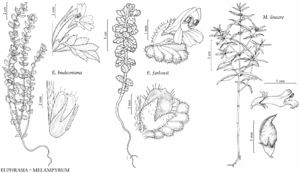Euphrasia hudsoniana
Rhodora 17: 194. 1915.
Stems simple or branched, to 35 cm; branches 1–5 pairs, from distal cauline nodes; cauline internode lengths (1–) 2–5 times subtending leaves. Leaves: blade lanceolate to ovate, 5–12 (–16) mm, base strongly cuneate, margins serrate to incised-serrate, teeth 1–5 pairs, apices subacute to acute. Inflorescences beginning at node 2–9; proximal internode lengths 1–2.5 times bracts, distal shorter than bracts; bracts green, sometimes purplish adaxially, broader than leaves, elliptic to ovate, length not more than 2 times width, 7–15 (–20) mm, base strongly cuneate, surfaces moreorless hirsute and hairs eglandular, teeth 2–6 (or 7) pairs, as long as or longer than wide, apices acute, sometimes aristate. Flowers: corolla white, adaxial lip tinged lilac, 5–6.5 mm, lips moreorless equal. Capsules narrowly oblong, 4–7.5 mm, apex truncate to emarginate.
Phenology: Flowering summer.
Habitat: Gravelly, sandy, grassy, and rocky places, often calcareous, coastal or shores of streams and lakes.
Elevation: 0–200 m.
Distribution
Alta., Man., Nfld. and Labr. (Labr.), Ont., Que., Mich., Minn.
Discussion
Euphrasia hudsoniana has been reported from Alberta; the voucher specimen supporting that occurrence has not been verified by the author.
The status of var. contracta P. D. Sell & Yeo and var. ramosior P. D. Sell & Yeo is unclear. Some specimens identified as var. contracta represent precocious states of var. hudsoniana. Variety ramosior specimens look very different from typical var. hudsoniana, resembling the hybrid Euphrasia nemorosa x E. hudsoniana. But variation in their characters is consistent, particularly their minute corollas and type of pubescence, which is not typical of Euphrasia hybrids.
Selected References
None.
Lower Taxa
"broader" is not a number.
